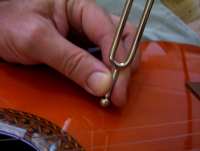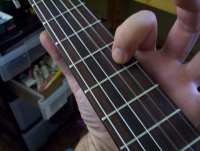| The Classical Guitar Tutorial for Beginners | |
|
|
|
| Chapter Seven: Tuning Your Guitar | |
|
This is the part of guitar playing that every beginner worries about. How do you know it is tuned right. If you never did anything like this before it is really not that hard. In no time at all it will become very easy for you. This section of the tutorial has pictures and movies to help you. The movies are in MOV format.
|
|
| Before starting the tuning process lets just make sure you can hold a note on your guitar. To make a note you firmly place a finger just before a fret on the fingerboard. The illustration at right shows the finger at the first fret. This is playing position 1 on the E or first string. Notice how the finger is just before the fret? And notice how the finger doesn't interfere with the other strings? Now pluck the string with your right hand. The note should sound clearly. If you hear rattling or buzzing you need to adjust your finger. If your guitar is properly tuned the note you are playing is "F". |
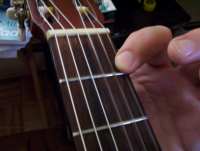 |
|
Now let's tune the guitar. If you have purchased an electronic tuner then follow the manufacturers instructions. This tutorial uses a tuning fork. It also includes video and sound so if you do not have a tuning fork you can use the video. |
|
|
In this tutorial I will be using a tuning fork with the note of "E" Grasp the tuning fork by the stem and firmly rap the tuning fork against the edge of an object like a table. (Do not rap the guitar with it). Now place the ball of the tuning fork against the sounding board of the guitar. The guitar will resonate with the note. Move the fork around the sounding board to find a loud spot. This note that you hear is "E". It is also the note that two strings on the guitar should be tuned to -the first and the sixth strings. They are both "E". |
If you don't have a tuning fork or an electronic tuner play this video and use the sound of the tuning for to tune your guitar. |
|
Now pluck the thinnest string on the guitar. This note should be the same as the tuning fork. If it isn't you should turn the tuning peg on the guitar until the note of the string matches the note of the fork. The image at right launches an MOV video where you can hear the string and tuning fork. Tightening the string will bring the note up. And loosening the string will bring the note down. |
|
|
Now you tune the second string (B). Pluck the first string. This is your (E) note. It is also the note of the second string when it is stopped at the fifth fret. With your finger in this position bring the note of this string to match the sound of the first string when it is played open. |
|
| Now stop the third string at the 4th fret. This note should match the sound of the 2nd string played open. This is a (B) note. |
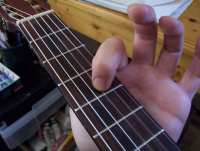 |
| Now stop the fourth string at the 5th fret. This note should match the sound of the third string as played open. Tune this fourth string up or down until the note of it matches the third string. |
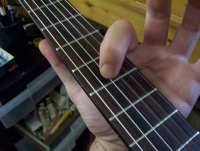 |
| Now stop the fifth string at the 5th fret. This note should match the sound of the fourth string as played open. Tune this fourth string up or down until the note of it matches the third string. |
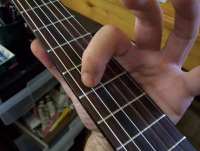 |
| Now stop the sixth string at the 5th fret. This note should match the sound of the fifth string as played open. Tune this fourth string up or down until the note of it matches the third string. |
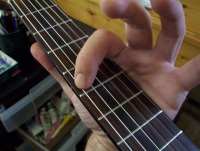 |
|
Is Learning the Guitar Taking You Forever? |
|
|
Your guitar is now tuned! |
|

